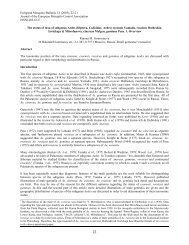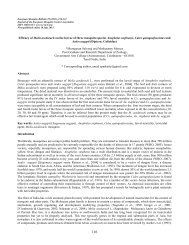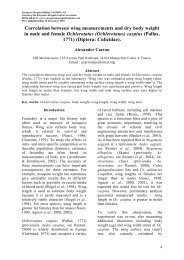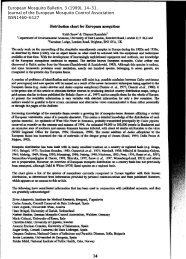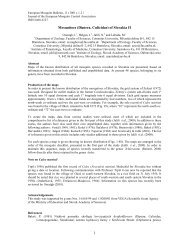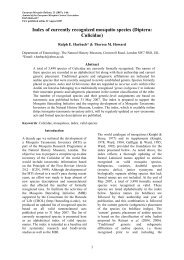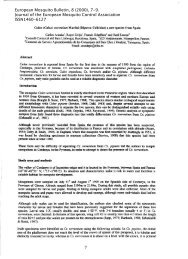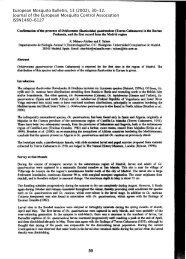distribution of the genus Anopheles in Europe. - European Mosquito ...
distribution of the genus Anopheles in Europe. - European Mosquito ...
distribution of the genus Anopheles in Europe. - European Mosquito ...
Create successful ePaper yourself
Turn your PDF publications into a flip-book with our unique Google optimized e-Paper software.
Cuenca, Granada, Huelva, Jaen, Madrid, Malaga, Murcia and Seville) (Enc<strong>in</strong>as Grandes, 1982; Eritja et al.,<br />
1998). Isolated records from Greece: Epirus (Lividas, 1931) and Drama (pandazis, 1935) are considered<br />
erroneous and probably referred to An. superpictus. Variations <strong>in</strong> adult coloration <strong>of</strong> both species, and<br />
especially <strong>of</strong> <strong>the</strong> arrangement <strong>of</strong> band<strong>in</strong>g <strong>of</strong> <strong>the</strong> female palps, have led to <strong>in</strong>stances <strong>of</strong> confusion between<br />
<strong>Anopheles</strong> c<strong>in</strong>ereus andAn. superpictus (Ramsdale, 1990).<br />
<strong>Anopheles</strong> (Cellia) multicolor Cambouliu, 1902<br />
A desertic species common <strong>in</strong> North Africa and with a <strong>distribution</strong> extend<strong>in</strong>g through <strong>the</strong> Sahara and <strong>the</strong><br />
Arabian Pen<strong>in</strong>sula to Pakistan. The only <strong>Europe</strong>an records are from <strong>the</strong> Spanish Prov<strong>in</strong>ces <strong>of</strong> Murcia and<br />
Almeria (Enc<strong>in</strong>as Grandes, 1982), <strong>the</strong> most arid region <strong>of</strong> <strong>the</strong> Iberian Pen<strong>in</strong>sula. As <strong>in</strong> <strong>the</strong> case <strong>of</strong> An.<br />
labranchiae, An. mu/ticolor may have been eradicated dur<strong>in</strong>g <strong>the</strong> course <strong>of</strong> anti-malaria operations and its<br />
current status is uncerta<strong>in</strong>.<br />
<strong>Anopheles</strong> (Cellia) sergentii (Theobald, 1907)<br />
The <strong>distribution</strong> <strong>of</strong> <strong>the</strong> anthropophilic An. sergentii sergentii extends from Pakistan, through <strong>the</strong> Middle East,<br />
<strong>the</strong> Arabian Pen<strong>in</strong>sula, <strong>the</strong> Sahara, Atlas and coastal regions <strong>of</strong> North Africa to <strong>the</strong> Atlantic and <strong>the</strong> Canary<br />
Islands. That <strong>of</strong> <strong>the</strong> zoophilic An. sergentii macmahoni extends from <strong>the</strong> Horn <strong>of</strong> Africa. through <strong>the</strong> savannah<br />
belt border<strong>in</strong>g <strong>the</strong> sou<strong>the</strong>rn edges <strong>of</strong> <strong>the</strong> Sahara <strong>in</strong>to Mali and northwards <strong>in</strong>to <strong>the</strong> Saharan oases, where some<br />
morphological <strong>in</strong>tergrad<strong>in</strong>g occurs (Gilles & de Meillon, 1968; Ram!i:llale & de Zuluetta, 1983; Senevet &<br />
Andarelli, 1955). Apart from a s<strong>in</strong>gle historical Bulgarian record reported by Markov & Morov (1929), <strong>the</strong><br />
presence <strong>in</strong> Pantelleria (an island <strong>of</strong>f <strong>the</strong> south coast <strong>of</strong> Sicily) <strong>of</strong> an apparently anthropophilic, but<br />
morphologically <strong>in</strong>termediate form (d'Alessandro & Sacca, 1967), is <strong>the</strong> sole record <strong>of</strong> An. sergentii north <strong>of</strong><br />
<strong>the</strong> African coast.<br />
<strong>Anopheles</strong> (Cellia) superpictus Grassi, 1899<br />
The <strong>distribution</strong> extends from nor<strong>the</strong>rn Pakistan and Mghanistan, through <strong>the</strong> Caucasus <strong>in</strong>to sou<strong>the</strong>rn<br />
Tadzikhstan and middle Asia, and through <strong>the</strong> Middle East and Asia M<strong>in</strong>or to sou<strong>the</strong>astern <strong>Europe</strong>. <strong>Europe</strong>an<br />
records are from Albania (coastal valleys) (Bates, 1941), Bulgaria (Gecheva, 1998), Croatia (Neratva Delta,<br />
North Dalmatia and Island <strong>of</strong> Pag) (Adamovic, 1983; 1984), France (Corsica only) (Moussiegt, 1986:<br />
Schaffner, 1998), Greece (A<strong>the</strong>ns, Epirus, Etolia, Euboea, Macedonia, Peleponnese, Thessaiy, Thrace, Corfu,<br />
Crete, Cyclades) (Waterston, 1918; Pandazis, 1935; Stephanides, 1937, 1938; Livadas & Sphangos, 1941;<br />
Peus, 1954; Samanidou-Voyadjoglou & Darsie, 1993), Italy (scattered foci <strong>in</strong> south and <strong>in</strong> Sicily, Calabria<br />
[Ionian and Tyrrhenian coasts]; not Sard<strong>in</strong>ia) (Coluzzi & Sabat<strong>in</strong>i, 1995; Romi et al., 1997), Macedonia<br />
(Greek border area) (Lepes & Vitanovic, 1962), Russia (Dagestan, Caucasus) (Gutsevich et al., 1971:<br />
Gornostaeva, 2000), Turkey (Edime, Kirklareli, Tekirdag Prov<strong>in</strong>ces) (postiglione et aI., 1973), Yugoslavia<br />
(Karst area <strong>of</strong> East Serbia, Pukovat) (Adamovic, 1987). There are four doubtful records from cont<strong>in</strong>ental Spa<strong>in</strong><br />
(Cordoba, Hue1va, Murcia) and <strong>the</strong> Canary Islands (Enc<strong>in</strong>as Grandes, 1982).<br />
References<br />
Adamovic, Z. (1979) Sibl<strong>in</strong>g species <strong>of</strong> <strong>the</strong> <strong>Anopheles</strong> maculipennis complex (Diptera, Culicidae) <strong>in</strong> Maeva and<br />
Pocer<strong>in</strong>a, Serbia. Acta Parasitologia Iugoslavica (Zagreb) 10, 21-26.<br />
Adamovic, Z. (1980) <strong>Anopheles</strong> messeae Falleroni <strong>in</strong> Serbia and Macedonia. Acta Veter<strong>in</strong>aria (Beograd) 30,<br />
217-223.<br />
Adamovic, Z. (1982) Anophel<strong>in</strong>e populations (Diptera, Culicidae) <strong>in</strong> Srem, Serbia. Acta Veter<strong>in</strong>aria (Beograd)<br />
32,2-3; 131-138.<br />
10



